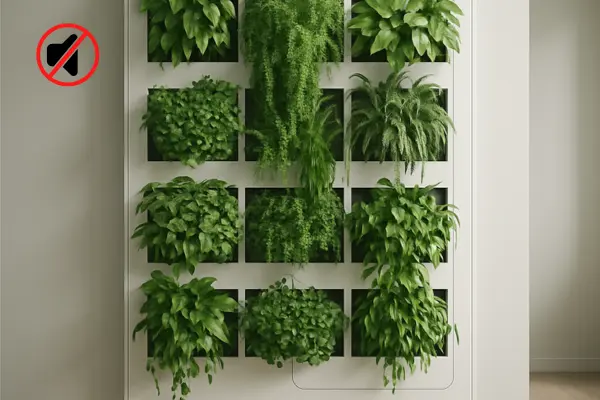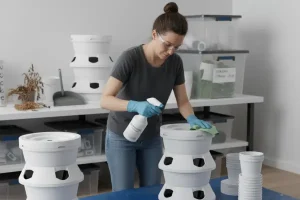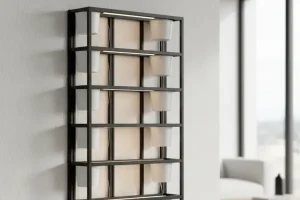A beautiful living wall should sound like… nothing. If your vertical garden hums, rattles, or gurgles, the noise usually comes from a few predictable places: pump vibration, water splash, air whine from fans, and tubing chatter. The good news: you can cut most of it with simple design choices—no expensive gear required.
This guide gives you a step-by-step plan to reduce noise in walls, towers, and rail systems. You’ll learn how sound travels, how to pick quieter components, and how to mount and plumb them so they stay quiet week after week. We’ll wrap with a weekend build plan, a quick “noise budget,” and common mistakes to avoid.
Why quiet matters
- Daily comfort: A persistent 40–50 dB hum in a small room becomes tiring fast.
- Better schedules: Quieter pumps and fans can run in short pulses during early mornings or evenings without bothering anyone.
- Apartment-friendly: Sound-tamed systems keep peace with neighbors and family.
- Plant health: When you reduce splash and turbulence, water delivery is often more consistent.
Noise basics (the 4 culprits)
- Vibration – Pumps and fans transfer tiny shakes into shelves, walls, and cabinets. Those surfaces act like speakers.
- Structure-borne noise – Rigid connections (screws, hard tubing) carry vibrations deeper into frames and walls.
- Air movement – Fans create whoosh and whistle when air squeezes through narrow gaps.
- Water acoustics – Free-fall drips, sharp elbows, and thin trays create splashing and gurgling.
Target sound levels (simple benchmarks)
- Whisper-quiet living wall: ~30–35 dB at 1 meter (library quiet).
- Acceptable apartment night level: ≤38 dB at 1 meter.
- Short pulses (pumps): Brief spikes up to ~42 dB are fine if total runtime is low.
A free phone dB app is enough for comparison. Measure at 1 m, at the same height as the pump or fan.
Choose quieter components (without overspending)
Pumps (submersible or inline)
- Flow vs. head rating: Pick a pump that meets your highest head height with 20–30% extra capacity. An undersized pump works harder (louder); an oversized pump throttled gently runs quieter.
- Mag-drive over brushed motors: Magnetic-drive pumps are usually quieter and easier to isolate.
- Rubber feet included? If not, add your own pads.
- Reservoir placement: A larger, lidded reservoir muffles pump noise and water resonance.
Fans (indoor walls)
- Diameter first, RPM second: Larger fans at lower RPM move the same air with less noise.
- Sleeve or fluid dynamic bearings are quieter than cheap ball bearings over time.
- PWM speed control lets you dial in just enough airflow to prevent mildew without a constant whoosh.
Tubing & emitters
- Soft silicone tubing absorbs vibration better than rigid vinyl.
- Pressure-compensating button emitters (2 L/hr) reduce hiss and sputter compared to micro-misters.
- Gentle slopes instead of hard elbows avoid slosh and gurgle.
Mounting for silence: how to stop vibration at the source
1) Decouple the pump
- Sandwich mount: Pump → thin rubber pad → mass layer (paver tile or dense cutting board) → thick foam pad → reservoir bottom.
- Why it works: The heavy middle layer lowers the pump’s resonant frequency; the foams break the path into the container.
2) Decouple the reservoir
- Soft feet or foam strip under the reservoir base.
- Avoid direct wall contact: Leave a small gap; don’t let the reservoir touch skirting boards or cabinets.
3) Soften all contact points
- Rubber grommets at pass-through holes.
- Neoprene washers wherever you screw brackets into metal frames.
- Velcro or silicone saddles to hold tubing; no hard zip-ties against metal rails.
4) Add a hush panel (if needed)
- For a wall-mounted control shelf, line the underside with mass-loaded vinyl or a thin cork/rubber mat. It blocks resonance without trapping moisture.
Plumbing that doesn’t gurgle
- Keep water under control: Deliver directly into media or distribution channels—avoid free-fall drops longer than 2–3 cm.
- Prime the lines: Run an initial long cycle to purge air; tiny bubbles cause ticking and hiss.
- Use gentle “S” loops: Replace right-angle elbows with wider curves to slow water and reduce slosh.
- Wider return path: If your system recirculates, make the return line one size larger than the feed line so water slides back silently.
- Quiet tray: Place a thin foam sheet or silicone mat beneath return trays to stop drumming.
Airflow without the whoosh
- Path, not force: Guide air across the foliage, not at it. Angle the fan to skim the wall.
- Avoid bottlenecks: Leave a 2–3 cm gap behind pocket panels for air to pass.
- Add a simple plenum: If you use an enclosure, cut a large intake low and a large exhaust high. Big openings = slower air = less noise.
- Run on a schedule: 10–15 minutes per hour during the day is usually enough. At night, 5 minutes per hour (or off if RH stays stable).
Scheduling to “hide” sound
- Morning-only irrigation: Watering between 06:00–10:00 avoids quiet hours and dries foliage by midday.
- Short pulses: For towers, 2–4 minutes ON, 10 minutes OFF, repeat 2–3 times. Short, predictable bursts are less noticeable than long drones.
- Night lockout: Block pump cycles after 20:00 unless absolutely needed.
- Fan ramping: Use smart plugs or PWM to run fans at a lower night setting.
The “Noise Budget” (plan it like watts or liters)
Allocate a maximum sound share to each component so the sum stays comfortable:
- Pump: ≤32 dB at 1 m during operation
- Fan: ≤30 dB at low/medium
- Water return: “inaudible at 1 m” goal (no splashing)
- Structure resonance: 0 (no rattle when you tap the frame)
Test one device at a time, then together. If combined noise is high, reduce the loudest item by 3 dB (that’s a clearly audible drop).
Weekend build plan: from hum to hush
Time: 1 day for retrofit; 1½ days if adding an enclosure.
Morning — Identify and isolate
- Baseline test: Run the system; use a phone dB app at 1 m. Note the peak.
- Touch test: Lightly touch the frame, reservoir, and wall. If sound changes, that surface is resonating.
- Pump isolation: Install the sandwich mount (rubber → mass → foam) under the pump; ensure the pump is fully submerged.
Midday — Quiet the plumbing
- Swap elbows for curves; add silicone tubing on final drops.
- Tuck emitters under foliage and near media; eliminate free-fall.
- Line return tray with a silicone or foam mat; verify a gentle slope.
Afternoon — Calm the airflow
- Reposition fan to blow across, not at, the wall; reduce RPM.
- Open a bigger vent on enclosures or add a second outlet to lower air speed.
- Decouple fan mounts with rubber grommets or silicone sleeves.
Evening — Program and verify
- Set morning pump pulses and a night lockout.
- Run the system again; measure dB. Aim for 30–35 dB.
- Tighten any loose panels; add neoprene washers under screws where needed.
Maintenance that keeps it quiet
- Monthly: Rinse pump intake sponge, flush emitters (warm water + a splash of vinegar), and re-seat silicone lines.
- Quarterly: Inspect foam pads and rubber feet; replace if compressed.
- After moves or cleaning: Re-check decoupling pads and re-measure dB.
- When plants get dense: Prune to restore airflow so the fan can stay at lower RPM.
Quick fixes (when something suddenly gets loud)
- New rattle? A screw or clip loosened; add a neoprene washer and retighten.
- Hiss from a single pocket? Air in the line; run one extra manual cycle to purge.
- Gurgle after refill? Return line partially submerged—raise the outlet to break a siphon loop or widen the return path.
- Pump “buzzes” on start: Add a soft-start timer (1–2 seconds delay) or increase submergence depth.
Common mistakes (and how to fix them)
1) Hard-mounting everything
- Problem: Screws + rigid surfaces transmit vibration.
- Fix: Use rubber washers, grommets, and foam spacers under brackets and shelves.
2) Undersized pump running flat-out
- Problem: High pitch, heat, and early wear.
- Fix: Choose a pump with 20–30% headroom and throttle slightly; it will run cooler and quieter.
3) Micro-misters in small rooms
- Problem: High-frequency hiss and excess humidity.
- Fix: Switch to pressure-compensating drip emitters (2 L/hr) aimed at media.
4) Water falling into shallow trays
- Problem: Drumming splash.
- Fix: Extend return lines below the waterline or add a silicone pad to break the fall.
5) Tight fan enclosures
- Problem: Air whistles through small slots; motors run hotter (louder).
- Fix: Enlarge intake and exhaust; add a short baffle to hide the opening but keep it wide.
6) Zip-tying tubing to metal
- Problem: “Chatter” as pumps cycle.
- Fix: Use silicone saddles or Velcro with a thin foam underlay.
Example layouts (quiet by design)
A) Indoor pocket wall (soil-based)
- Submersible mag-drive pump in lidded tote; sandwich isolation mount.
- Silicone main line to a compact manifold; 2 L/hr button emitters per column.
- Return tray lined with silicone; gentle slope to reservoir.
- 120–140 mm fan at low RPM, angled across wall; large top and bottom vents.
B) Balcony tower (recirculating)
- Low-RPM pump sized to head height + 30% margin.
- Central feed line with soft loops to each tier; no right angles.
- Non-slip rubber under tower base; reservoir decoupled from deck.
- Optional thin EVA mat behind tower to stop deck resonance.
Safety and moisture control
- GFCI outlet near any water.
- Drip loops in all cords so water cannot run into plugs.
- Vent gaps around enclosures; never seal pumps and lights in airtight boxes.
- Catch trays sized for expected runoff; empty within 30 minutes.
Quiet is not worth risking safety—always give water and electricity generous separation.
Summary & next steps
To build a truly silent vertical garden, treat sound like any other resource: plan it, measure it, and manage it.
- Pick quiet-leaning components (mag-drive pump, larger low-RPM fan, silicone tubing).
- Decouple pump, reservoir, and mounts to stop structure-borne noise.
- Calm the water with gentle slopes, wider returns, and drip emitters aimed at media.
- Guide air, don’t force it—big openings, slow fans, cross-flow.
- Run short morning pulses and set night lockouts.
- Keep it that way with monthly flushes and quarterly pad checks.
Follow this playbook and your wall will deliver lush growth and a peaceful room—no hum, no rattle, no fuss. If you want, I can adapt this into a printable “Silent System Checklist” tailored to your exact wall size, pump head, and room layout.




